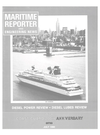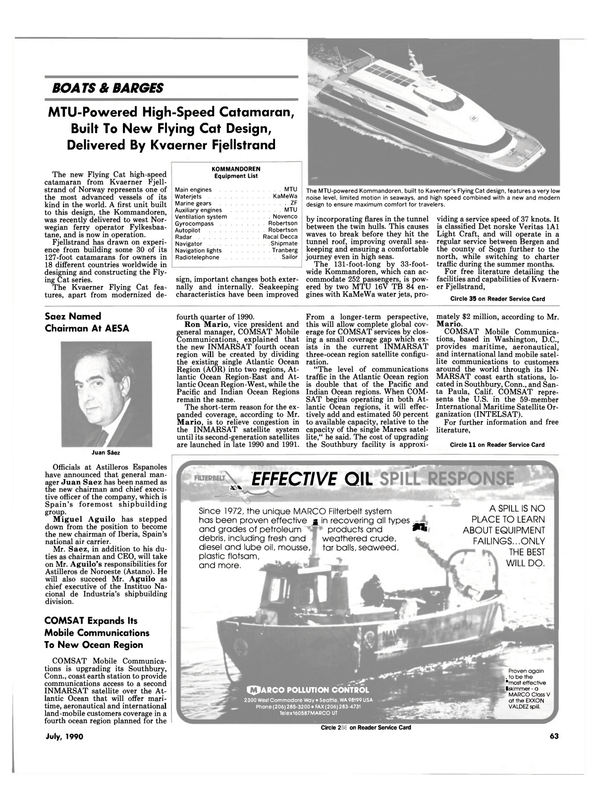
Congressional Conferees Near Compromise On Double-Hull Tanker Phase-In
U.S. Yards Could Gain $ 6 . 6 Billion In Retrofit Work The Congressional legislative battle over double-hull/double-bottom tankers appears to be drawing to a conclusion. According to reports, House and Senate conferees are currently working on compromise legislation as part of the pending oil spill liability and compensation bill which would gradually phase-in double hull tankers starting in 1995.
The compromise is expected to be similar to a program recently outlined by attorney Charles B. Anderson of the New York law firm Haight, Gardner, Poor & Havens, at a forum held in New York by the World Trade Institute. According to Mr. Anderson, whose firm represents tanker owners and insurers, all tankers in excess of 40 years old would be required to have double bottoms by 1995, while all tankers more than 25 years old would be required to have double hulls by 2005.
The compromise differs from the current proposal by the House of Representatives, which would make double hulls mandatory on oil tankers calling at U.S. ports by the year 2005. The House proposal would also require all new construction tankers to be built with double hulls, effective on the date that the legislation is enacted. Inland barges would be required to be built with double hulls by 2015, while existing barges would have until that time to be retrofitted.
The Senate version, on the other hand, provides the administration with much more freedom in determining which ships would be required to have double skins and when the legislation would be implemented.
The Bush Administration, which, for quite some time, resisted the inclusion of mandatory doublehull tanker legislation as part of the oil spill bill, recently announced its support for a gradual phase-out of single-skin tankers beginning in the year 2000.
In a letter sent to key House maritime leaders, Secretary of Transportation Samuel K. Skinner detailed the administration's plan.
"The administration generally supports requiring double hulls on new construction of oceangoing tank vessels, if consistent with the findings in the National Academy of Sciences report that double hulls are safe and afford a better protection to the environment than other design features. We believe that existing single-skin, oceangoing tank vessels should be phased out after they are 25 years old (beginning in the year 2000)." According to Mr. Skinner's letter, the phase-out would also include single-skin vessels utilized in lightering operations in the U.S.
200-mile exclusive economic zone.
However, the administration did provide an exemption for vessels operating at deepwater ports.
Secretary Skinner said in his letter: "On the basis of the Louisiana Offshore Oil Port's (LOOP) distance from land and excellent record, we do not object to an exemption for vessels servicing a deepwater port licensed under the Deepwater Port Act of 1974, until the year 2015, provided that such an exemption would end when and if before that date an international doublehull standard is implemented." With regard to tank barges servicing the inland waterway system and tank vessels operating exclusively on the Great Lakes, the administration supports double-hull requirements beginning in 2015. The administration based its decision on the fact that freshwater vessels have generally longer service lives than oceangoing vessels. The administration sees this as an inducement to owners to build only double-hulled inland barges and Great Lakes tank vessels.
If mandatory double-hull legislation is passed by the government, it would be a tremendous boost as well as a challenge to U.S. shipyards.
According to the Washington, D.C.-based American Petroleum Institute, it would cost about $30 million to retrofit a tanker with a double bottom, while a tank barge retrofit would cost about $1.1 million.
Based on API projections, the 153 U.S.-flag tankers could be retrofitted at a total cost of $4.6 billion, while the cost of retrofitting the some 1,800 tank barges operating in U.S. waters would be about $2 billion.
In addition, since the legislation would affect all tankers entering U.S. ports, between 400 to 500 foreign flag ships would also have to be retrofitted. The cost of retrofitting these vessels, according to API, would be about $10 billion.
The $16.6 billion cost of retrofitting does not include any new tanker or tank barge construction.
Read Congressional Conferees Near Compromise On Double-Hull Tanker Phase-In in Pdf, Flash or Html5 edition of July 1990 Maritime Reporter
Other stories from July 1990 issue
Content
- Wartsila Diesel Announces Executive Appointments page: 10
- Chandris Celebrity's 'Horizon/ Built By Meyer Werft, Makes Her New York Debut page: 11
- Furuno Introduces New Autopilot, Compact, Lightweight Gyrocompass, And 10-Inch Color Video Sounder page: 11
- Radio Holland's Datamation: A Complete Integrated Ship Management System page: 13
- McDermott Awarded $27-Million Exxon Contract For Offshore Platform page: 13
- Avondale To Bid On Construction Of World's Largest Passenger Ship page: 14
- Singmarine Wins $16 Million Contract For New Chemical Tanker page: 15
- Hamilton Introduces Advanced Water Jet For Wide Range Of Vessels page: 16
- Halter Marine To Convert Supply Vessel For EPA Under $4.2-Million Pact page: 18
- Magnavox Introduces New Integrated GPS/Transit Satellite Navigation System page: 18
- Leevac Shipyards A w a r d ed Supply Boat Contract page: 19
- DIESEL POWER REVIEW page: 20
- MARINE LUBRICANTS page: 28
- U.S. Coast Guard Celebrates 200 Years Of Service page: 33
- Our Third Century page: 34
- Overview Of Coast Guard's Fiscal Year 1991 Request page: 36
- Willard Marine Continues Work With U.S. Coast Guard; Introduces SOLAS-Approved 18-Foot RIB page: 42
- Bollinger Receives $73.4-Million Modification To Build USCG Patrol Boats page: 42
- Morgan Crane Receives Order For Knucklebooms For Three Corvettes page: 43
- New Navy Report Outlines Potential Submarine Threat From Third World Nations page: 44
- US Navy Homeports Select Seaward Marine Fenders page: 44
- NORSHIPCO Completes Conversion of Crane Ship (T-ACS 9) For Navy page: 45
- Tano Marine Named Single System Vendor For T-AGS 45 page: 45
- Marinette Marine Launches Its Third MCM Vessel USS Patriot (MCM-7) page: 46
- Essex Machine Works Delivers New Steel Propeller Shafts For Coast Guard's 'Eagle' page: 48
- Viking Seminar Updates Skills of Service Representatives page: 48
- Global Marine Group Changes Company Name To GMG Systems, Inc. page: 53
- Robert Allan-Designed Hydrographic Survey Vessel Delivered By Allied Shipbuilders page: 54
- Aluminum Boats Constructing 140-Foot Dinner Yacht For Chicago page: 54
- Bender Awarded $3-Million Contract For Drill Rig Repair page: 55
- Cummins Diesels Power Cruise Vessel 'America' Delivered By Marine Builders page: 56
- ZF Introduces New Series Of Economical High-Horsepower Marine Transmissions page: 56
- $13-Million, Five-Boat Contract Completed By Moss Point Marine With Delivery Of Tugs To Jordan page: 58
- Deutz MWM Diesels To Power Four Harbor Tugs For Mexico page: 58
- Atlantic Marine Awarded $12.6-Million Contract To Build Three Sternwheel Dinner Vessels page: 59
- ABB Marine To Supply $50-Million Power Package To Fincantieri page: 59
- Blount Marine Delivers 192-Foot Dinner/Excursion Boat M / V Spirit Of Boston page: 60
- Canadian Government Report And New U.S. NOAA Administrator Publish Strong Swath Endorsements page: 61
- Master Marine Completes Repair, Maintenance On USCG Island Class Patrol Boats page: 62
- Trinity Marine To Build Three 220-Foot Supply Boats Under $15-Million Contract page: 62
- MTU-Powered High-Speed Catamaran, Built To New Flying Cat Design, Delivered By Kvaerner Fjellstrand page: 63
- COMSAT Expands Its Mobile Communications To New Ocean Region page: 63
- New Paint Factory For Sigma In Amsterdam page: 64
- Allied-Signal 'Spectra Shield' Panels For Marine Vessels Offer Maximum Ballistic Protection page: 64
- Textron Marine Systems Wins $6.5-Million Contract To Build Two SES Fireboats page: 65
- Congressional Conferees Near Compromise On Double-Hull Tanker Phase-In page: 66
- New Literature Available On Coffin Mechanical Seals For Turbo Pumps page: 67
- ABB Offers Eight-Page, Full-Color Brochure On Turbochargers page: 68
- Marco Shipyard Christens Fourth North Pacific Freezer Longliner page: 68
- Versatile Pacific Shipyards Uses N e w Launching Technique For Hydrographic Survey Ship page: 69
- L&C Associates Completes Deactivation Of M / V Cape Inscription page: 70


